How to create the best About page? (Best practices for about page with examples)

Why is the About page important?
Let's find out which of your pages is the most important to your visitors. Let's open your Analytics and look at the page's report. They will all be at the top. And it is a sure thing to find your about page in that mix.
It's your about page.

After your blockbuster blog post. It would be found in your top 10 pages. It usually is in the top 5. It is usually true in all the Analytics accounts or at least of all the accounts that I came across.
And it should not be a surprise because about page usually answers all the big questions that the visitor may have like:
- Who works there?
- What are their beliefs?
"This behavior of the visitor should not be something that we should be surprised of. It just reinforces the human psychology. We buy from people, not companies or robots. Visitors want to feel a direct connection with them. So, when visitors go to your About page, they want to be moved, they want to feel some connection and they want to know your values. They want to know whether they are buying from a human or not"
If you still have doubts that your values are important to your visitor, then you should look at the data from the Edelman Trust Barometer. They conducted a global survey of 36,000 respondents in 28 countries. The main purpose of the survey was to track how people trust and perceive.
This research concluded that more than any time in the 22-year history of the survey, customers, clients and job candidate want to know about your belief and values. According to survey's key findings, distrust has become the default emotion of society.
"Nearly 6 in 10 say their default tendency is to distrust something until they see evidence it is trustworthy"
58% of respondents said they make purchases from companies based on their values and beliefs. Additionally, 60% of job seekers base their decision on the company's beliefs and values.

All of this evidence makes it clear that your About Page is a critical step on the path of your next lead. It tells your story and answers all the big questions that are important to your prospects and candidates.
Best Practices for About page
Like all web design best practices, these are just guidelines, not some ridged rules that you have to follow. None of them are mandatory. Each of them aligns with storytelling and answering visitors' specific questions.
Here is the template so we can see them all at once.
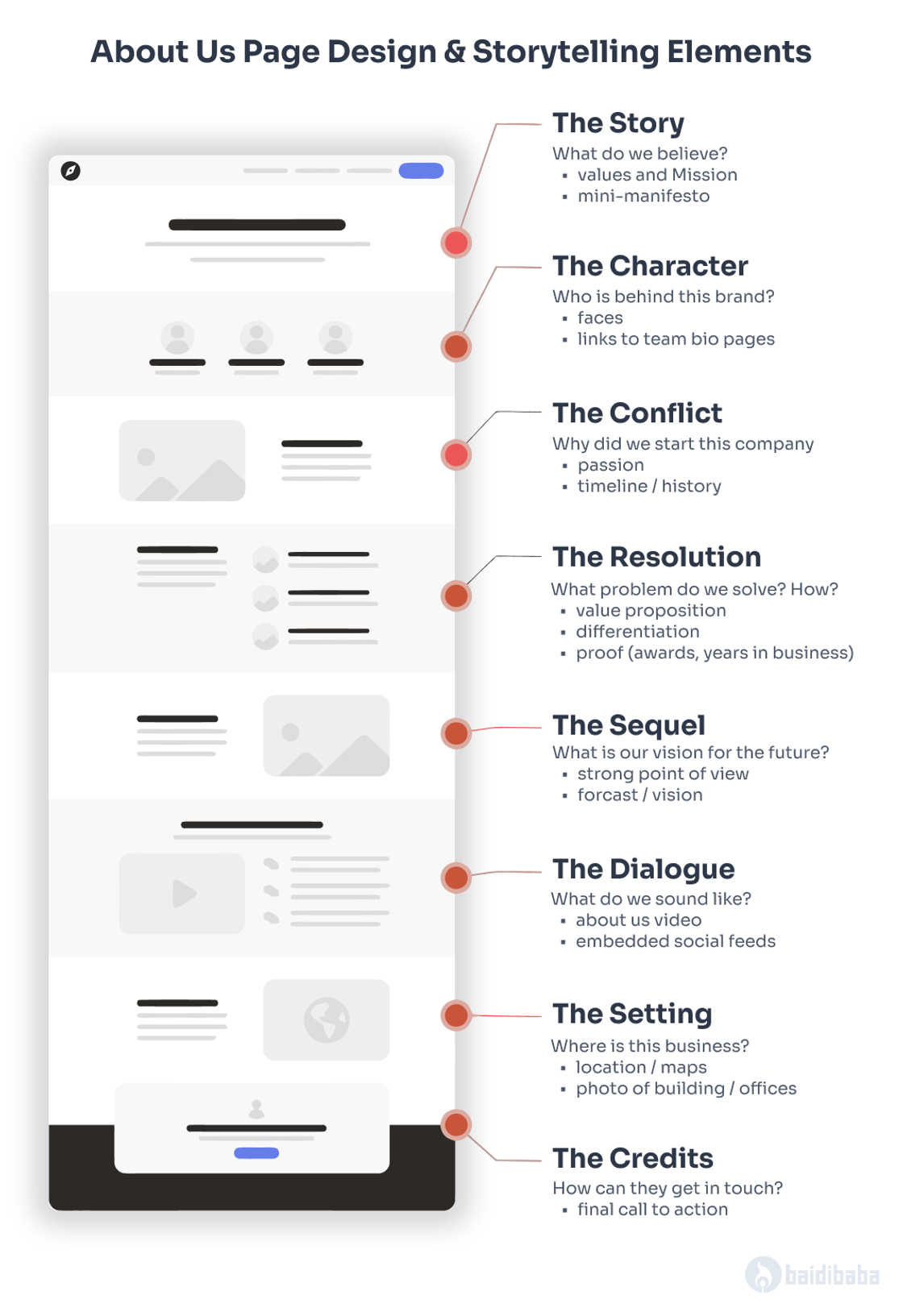
So before we break down each of the best practices in detail. Let's look at some of the design considerations that will help answer the UX question: How to design an About page.
Web Design Considerations
What should be your navigation label?
The item in your main menu. It doesn't make any difference in clickthrough rates based on the navigation label it can be: About (or About Us), Company Profile, Our Story, Firm Profile.
It just has to convey that the page is specifically about the brand and the people.
Should it be a single page?
For some sites the content can be more than one page. It works fine, but watch out for "thin content." There is no need to make a separate page if your content is just 100 words. Don't break pages unless pages are long.
Add visuals
Yes, visuals are very important for the about page. It is the best place for a video or a short 5 minute documentary about the brand. This is also a key place to add images of your people and badges like awards, certifications, memberships or other trust seals.
Add a call to action (CTA)
Your About page also answers sales questions like any service page in your website. So it should be no surprise that the About page is on the path to converting. With this in mind, it should include a call to action.
While you can add a CTA button for email signups for content marketing, remember that this is a page for your prospects and customers. So it's better to create a call to action for your primary offer, for generating leads.
Should we add Keywords?
About pages are not an opportunity for search engine optimization (SEO) because they are not focused on a key phrase. Unlike service pages and articles, which often target key phrases, About pages do not target a phrase other than a brand, and the home page is ranked accordingly.

1. Who is behind this business?
Story Element: Characters
The people are crucial. One of the most crucial components of any website is you. Every page should have people on it, but the About page must have people. Many of the people that visited the page specifically sought you out.
Example About Page: This website puts the users first, with a team photo at the top of the about page. It is genuine. It distinguishes itself.
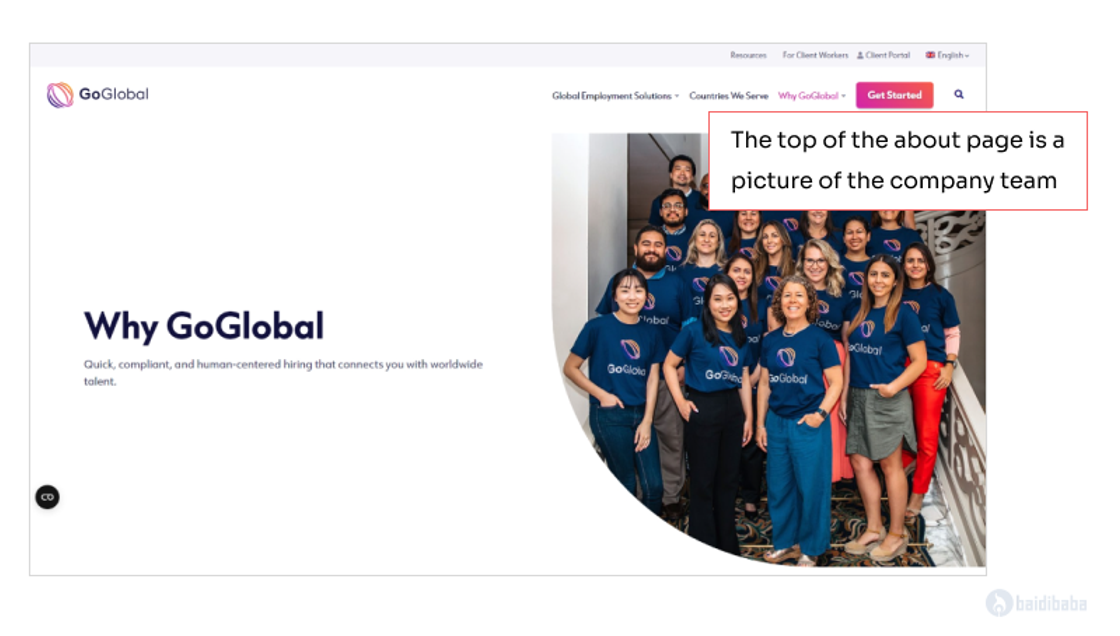
Characters appear in stories. Define the team members now. Your client, though, is the other main character in your story. Here is a good place to name your audience in the story.
Make a page for each person so that visitors who are interested in learning more about them can do so. Without it, you'll never rank for the names of your team members. This is the key to personal SEO.
After introducing our team, the plot of the story begins to take shape. But don't overdo it.
2. Why did they start this company?
Story Element: Conflict
You'll next explain to your guests how you challenge the current quo. Tell them how the lack of your company was a failure of the world economy, or at the very least how the founders were so passionate about starting the company that they had no choice but to do so.
The two primary categories of conflicts:
Unexpected journey
This is the internal conflict of passion.
We just had to stop everything and start the business because we enjoy this work so much.
A stranger visits the area
This major external conflict resulted from an unmet need or a market gap. It was an issue that required attention. It was necessary to slay the dragon.
In either case, there is a problem that need to be resolved.
Both types of stories are combined on certain About pages. They draw attention to the scope of the issue before illustrating its effects on the founders or other stakeholders personally. The target audience recognizes the issue and subsequently empathizes with the founders' suffering.
Example About Page: The size of the issue is the first thing mentioned on this About page, and it is measured in terms of money, time, and conflicts. The founder then follows up with a letter that tells a true narrative that connects with the audience more deeply.
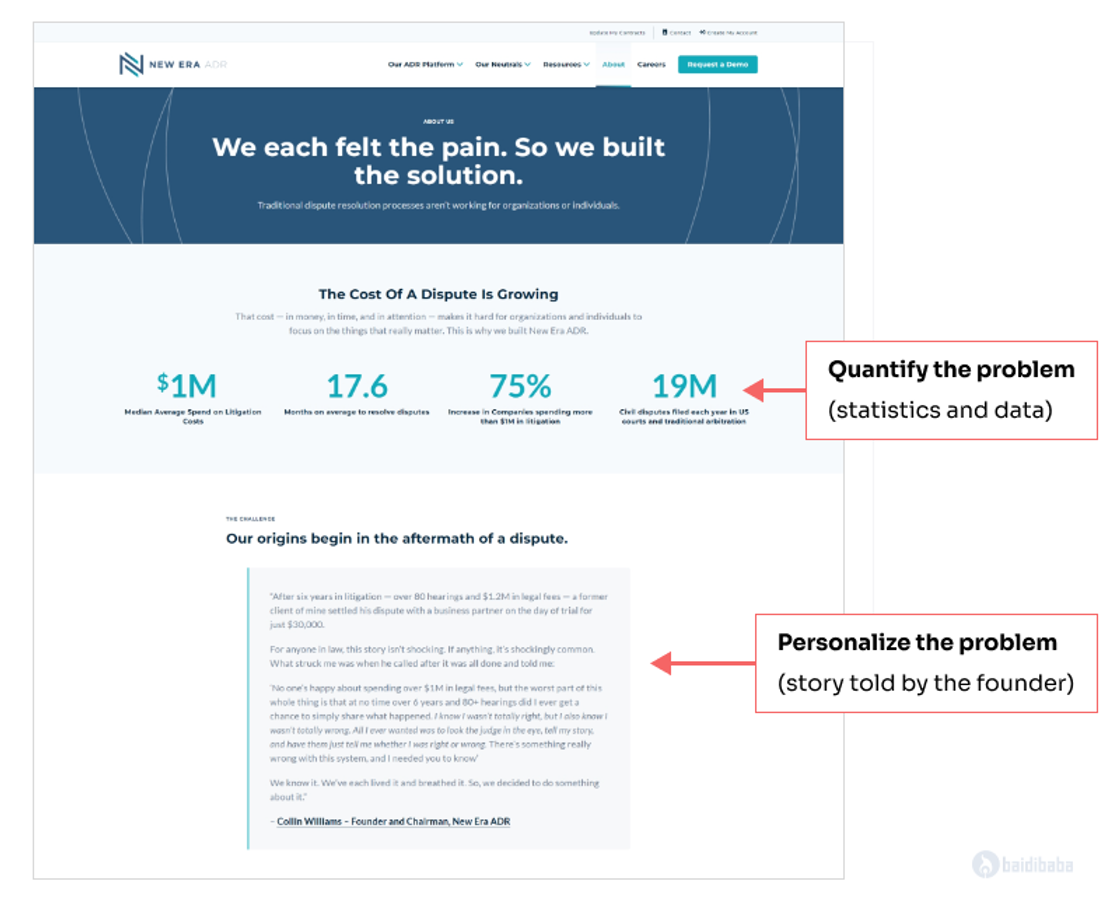
3. What do these people believe?
Story Element: Plot
The story reveals the beliefs of the brand's creators, or they can be stated plainly in the mission statement, core values statement, or even brand manifesto. A manifesto is a pledge that expresses a company's principles and says, "We declare that as a corporation, we will always do X." It makes a clear and potent statement.
Example About Page: The crew, the founders, the company's mission, and its principles are all displayed on this about page. Visitors understand who and why right away.
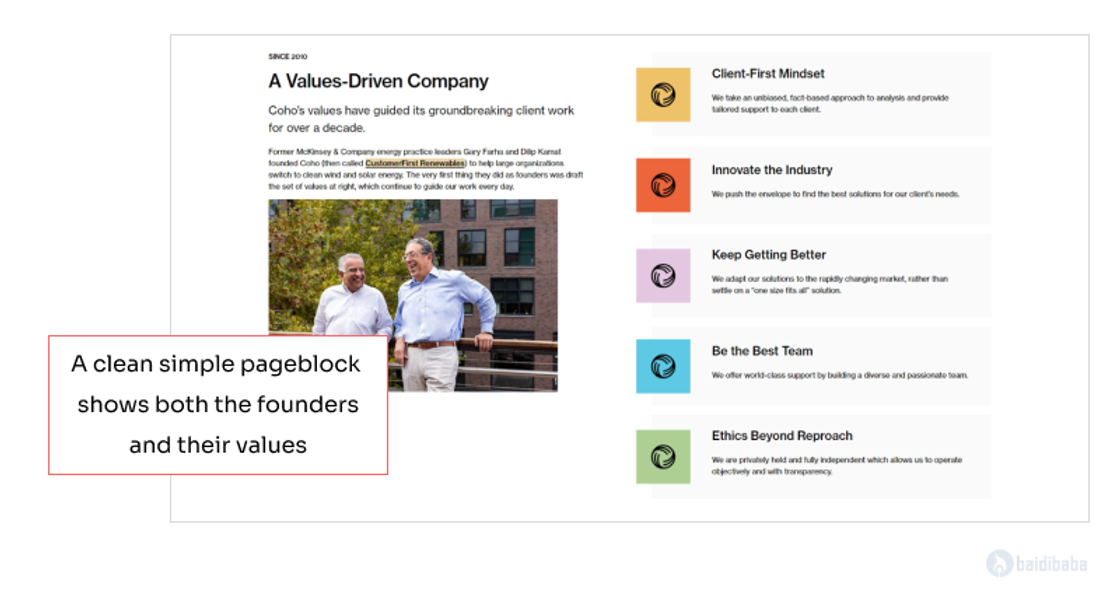
Sharing your principles and demonstrating how you are putting them into practice are other ways to demonstrate what you stand for.
Other means exist to demonstrate your virtues. Some honours and affiliations, as well as some certifications (the B Corp accreditation, for instance), are in line with certain virtues. These has benefit from being visual. They act as differentiators and trust-builders when they are included on an about page.
4. What problem do they solve and how?
Story Element: Resolution
The brand and its services serve to settle the conflict for both types of characters—the client and the brand. The brand exists to address the issue, and its actions are the solution.
In other words, the results and the value proposition follow the conflict and the values. Therefore, here is your chance to briefly reintroduce the product or service. Idealized, it contains
- Describe how your resolution is unique. Your strategy is distinct, ideally as a result of the values it is based on.
- Add evidence in support of your abilities to settle the dispute conflict. This could be social proof or data.
Example About Page evidence: Thes About page begins with proof before presenting the services and highlighting how they vary from other strategies.

It's okay if this gives your About page the impression of being just another service page. Keep in mind that it's a step toward conversion. It sells while while telling a story. A click on call to action is the desired result.
5. What do they sound like?
Story Element: Dialog
The key on your keyboard with the most power is the quotation mark key.
When anything is surrounded by quotation marks, it transitions from copywriting to an opinion. It gets more human-like. It also makes use of dialogue, one of the most powerful story elements.
Simply by adding a face and quote marks, you can change a statement of service into a statement of values. What we do becomes "why we do it," and vice versa. It is a testament even though it is not a testimonial.
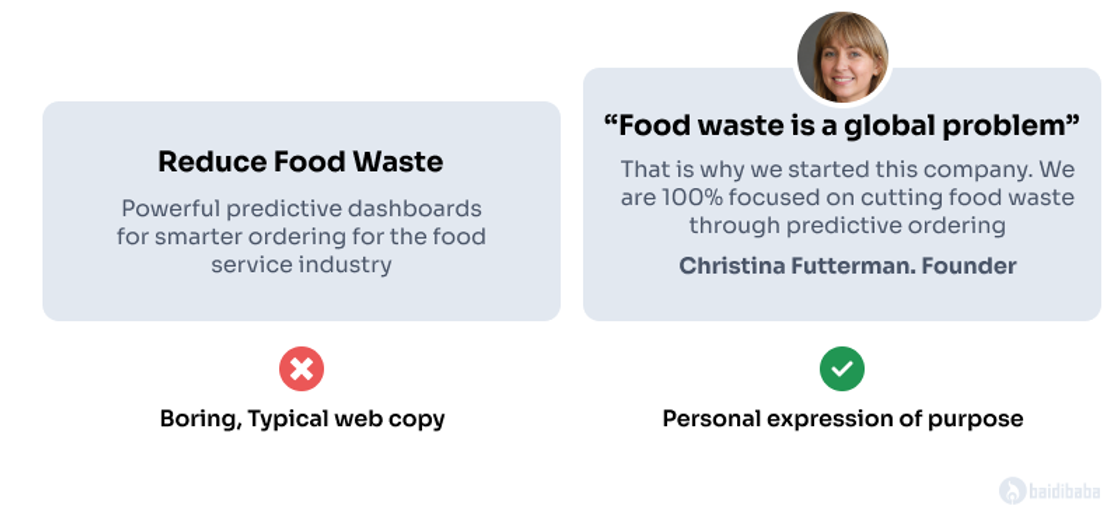
One of the three ways to allow the visitor to hear and experience the brand's source is through this.
- Leadership and team member quotes: Simple to add and promotes a sense of connection.
- Videos with the team's leaders and members: The mini-documentary-style "About Us" video highlights the narrative and company principles.
- Integrated social media feeds on the about page: Recent social media activity's images can present the team, the culture, and the values.
- Embedded blog postings on the about page: especially when the content package features strong opinions and thought leadership.
Example About Page thought leadership: This about page features quotes, trust seals, history and values. But it also has the blog feed at the bottom. This invites visitors to jump into the content, where the voice of the brand comes through. And of course, it's a responsive design so it works well for mobile users.

6. What is their vision?
Story Element: Sequel Preview
Not every About page template includes this. An about page generator will overlook this. And many companies simply ignore this section. However, the About page is the ideal place to outline an industry-wide or brand-specific future vision.
- What's our next destination?
- How does this fit with our beliefs and the requirements of our clients?
- What do we anticipate taking place that others deem unlikely?
- What long-term issue is most pressing for our sector?
- In 25 years, what will we be doing?
Another chance to differentiate the brand by expressing a strong perspective.
7. Where is this business?
Story Element: Setting
Every story also has a setting. Even multinational corporations have local teams in several locations. Visitors do not need to visit the Contact page in order to find out where you are if the About us page has the address.
The location is frequently mentioned while presenting the characters and the conflict, but not all visitors will be reading-ready. Here are two examples of visual responses to the inquiry "where are you?"
- Images of the workplace interiors or exteriors
- Location maps
Example About Page Map: On this About page, they demonstrate rather than describe their global reach. The drop-down menu directs visitors to the closest place, and the small map is a straightforward visual feature that reveals which nations they are in.
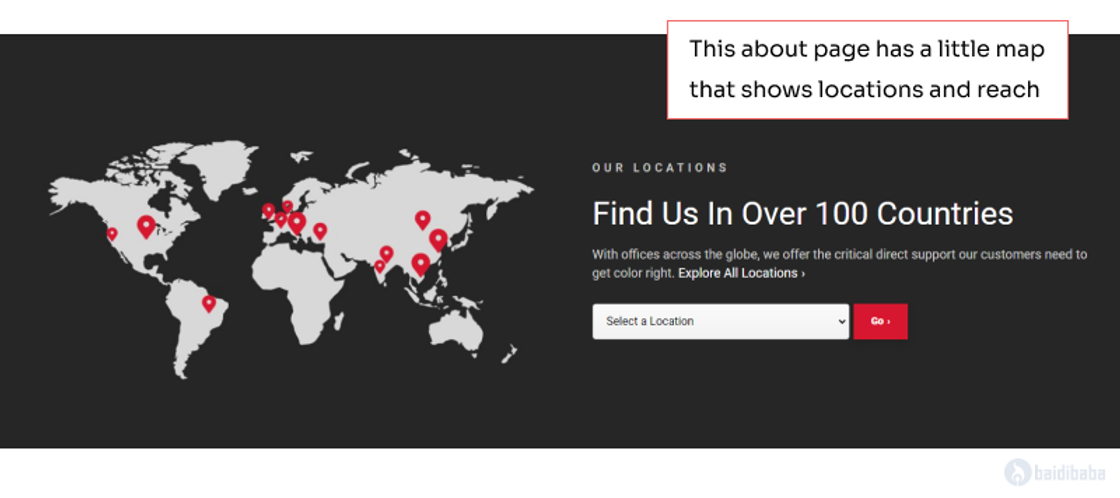
Note
Don't spend too much time on "we love us" narrative. Don't just keep writing about yourself and about how great you are. Rather than addressing the visitor point of view, don't keep writing "we" in every sentence. The visitor is here looking for your people, your story and your values. So don't keep ranting about how great you are.
Give your visitor what the came here for and share your story. Make it personal, so they can connect with it. Show why your brand is in business. And support it with evidence.
Once you improve the about page you have improved a key step on your user's experience.If you've told your story well, don't be surprised if you see an increase in leads.
